Mikoyan-Gurevich MiG-29 'FULCRUM'
Role: fighter, multi-role fighter
Design: Mikoyan-Gurevich OKB
Builder: NAZ Sokol/MAPO MiG (RAC MiG)
Variants: MiG-29 (Fulcrum-A), MiG-29UB/UBT (Fulcrum-B), MiG-29C (Fulcrum-C),
MiG-29K/KVP (Fulcrum-D), MiG-29M/ME/MT, MiG-29N, MiG-29S/SD/SE, MiG-29SM/SMT,
MiG-29MRCA/M/M2, MiG-29OVT, MiG-29K/MiG-29KUB, MiG-35
Operators (incl. former): Russia, USSR, Algeria, Angola, Azerbaijan, Bangladesh, Belarus, Bulgaria, Cuba, Czechoslovakia, Czech Republic, Eritrea,
East Germany, Germany, Hungary, India, Iran, Iraq,
Kazakhstan, Malaysia, Moldova, Mongolia(?), Myanmar, North Korea, Peru, Poland, Romania, Serbia and Montenegro, Serbia, Slovakia, Sudan, Syria,
Turkmenistan, Ukraine, Uzbekistan, Yemen, Yugoslavia
The MiG-29 (NATO reporting name 'Fulcrum') is a single-seat air superiority fighter, developed by
Mikoyan Design Bureau. Although it had little sophisticated avionics and no fly-by-wire
flight control system, the MiG-29's agility and manoeuvrability made it equal to the contemporary
Western fighter aircraft, like the F-16 and F-15. The two
powerful RD-33 turbofan engines give the MiG-29 a high thrust-to-weight ratio, enabling vertical
climb with acceleration. The MiG-29 was the first fighter to be equipped with dual-mode air intakes.
When in the air the large intakes under the fuselage take in the air for the engines. On the ground,
these intakes are closed and the much smaller intakes on top of the forward wing take in the air. This
reduces the chance of objects to be sucked into the engines, enabling the MiG-29 to operate from
unprepared airstrips.
The MiG-29 is equipped with the N019 Rubin (NATO 'Slot Back') radar, enabling the MiG-29 to intercept
air targets beyond visual range with R-27 missiles. The forward looking infra red search and track (IRST)
sensor provides target acquisition for IR guided missiles, such as the R-60 and R-73 missiles. The
helmet mounted target designation reticle, combined
with its high turning agility and manoeuvrability, enables the MiG-29 to engage targets with IR guided
weapons at close range outside the MiG-29's forward direction.
The MiG-29 was widely exported to nearly 30 countries and is still operated in large numbers. For most
countries the MiG-29 remains the most capable aircraft in service or remains on duty for air defence alongside modern multi-role types. Several MiG-29 upgrade
packages are offered to current operators, as well as upgraded and new versions for possible new operators.
The MiG-29 received new equipment, including fly-by-wire and improved N019M Topaz radar or new N010 Zhuk radar with mechanical array up to
active electronically scanned array (AESA) vastly improving detection ranges and tracking of multiple targets.
Weapon options were expanded with Russia's latest generation of improved AAMs, including the RVV-AE (R-77)
active radar-guided AAM, advanced air-to-surface missiles and precision guided munitions. Also the RD-33 engines
were improved and the MiG-29OVT demonstrated TVC equipped engines. Besides upgrades and second-hand aircraft, the modernized MiG-29 has not
been much of an export success compared to the Su-27/Su-30. However in recent
there have been two major developments for today's Russian Aircraft Corporation MiG (subsidiary of UAC).
India's need for a carrier-borne fighter saw the relaunch of the MiG-29K navalized version, implementing the improvements
and equipment developed and tested for the various improved MiG-29 multi-role variants up to the MiG-35.
Russia subsequently also decided to procure the MiG-29K to replace the Russian Navy Su-33
carrier-based fighters. Recently, the Russian MOD has also decided to procure new MiG-35 fighters over the coming decade
to allow the retirement of the oldest MiG-29s still in service. Until the MiG-35S arrives, the upgraded MiG-29SMT aircraft
that were originally destined for Algeria are the most modern and capable Fulcrums in operational service in Russia. In 2014,
Russia placed an order for another batch of MiG-29SMT fighters.
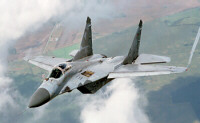
MiG-29 'Fulcrum'
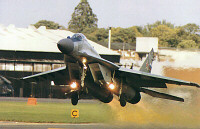
MiG-29 taking off
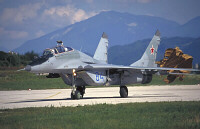
MiG-29UB trainer
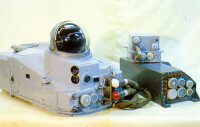
IRST sensor equipment
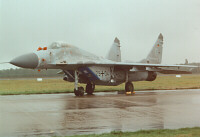
German MiG-29 Fulcrum

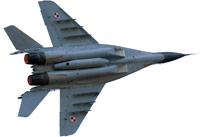
 Back to Index
Back to Index